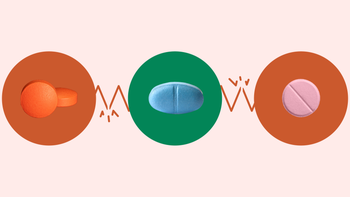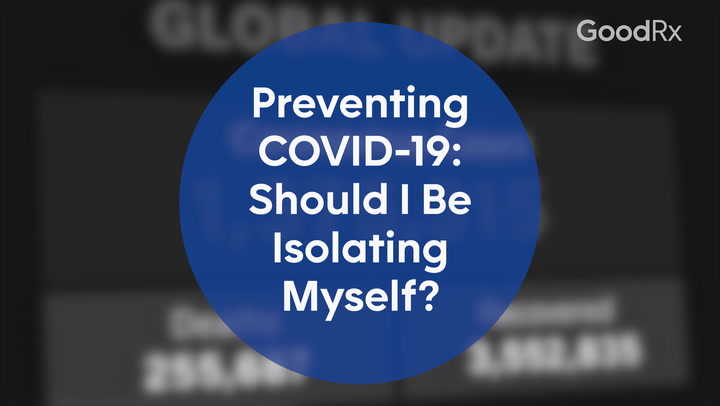
Naproxen (Aleve) vs. Ibuprofen (Advil): Which Is Better?
Key takeaways:
Naproxen (Aleve, Naprosyn) and ibuprofen (Advil, Motrin) are both nonsteroidal anti-inflammatory drugs (NSAIDs) that are available over the counter (OTC). They’re commonly used for pain and inflammation.
Naproxen and ibuprofen should start working as soon as 30 minutes after your dose. But it could take a few hours to see their full effects. Both medications have similar side effects such as an upset stomach, dizziness, and heartburn.
The key differences between the two medications are that naproxen lasts longer in the body and may be less likely to cause heart risks, such as heart attacks. Ibuprofen, though, may be less likely to cause stomach bleeding or ulcers. However, these risks are rare in general. Ibuprofen is also preferred in children ages 3 months to 12 years.
The primary difference between OTC and prescription naproxen and ibuprofen is the tablet strength — prescription tablets have a higher strength.
Access savings on related medications
Table of contents

Naproxen (Aleve, Naprosyn) and ibuprofen (Advil, Motrin) are two common medication choices for muscle aches, joint pain, and inflammation from conditions like osteoarthritis. Like many other nonsteroidal anti-inflammatory drugs (NSAIDs), both are also readily available over the counter (OTC) in pharmacy and retail store aisles. So when comparing naproxen versus ibuprofen, which option is best for you? Let’s take a look.

Naproxen vs. ibuprofen: Which is more effective?
NSAIDs like naproxen and ibuprofen are similarly effective for acute and chronic pain relief. They both help relieve aches and pains in the joints and muscles, just like other NSAIDs do.
All NSAIDs are very effective compared to placebo, which is a pill with no medication in it. But the difference in effectiveness between NSAIDs is often unclear. Ibuprofen and naproxen are so similar that overall, one isn’t considered better than the other for treating pain and inflammation in adults.
But for children ages 3 months to 12 years, ibuprofen tends to be the preferred choice. This is because ibuprofen has been studied more than naproxen in children under the age of 12.
Search and compare options
Ibuprofen or naproxen can be used to treat several conditions, including fever, muscle or joint pain, and headaches. While NSAIDs are also helpful for mild-to-moderate migraines, triptans like sumatriptan (Imitrex, Tosymra, Zembrace Symtouch) are considered first-choice medications to treat moderate-to-severe migraines. But researchers have found that using both a triptan and an NSAID can be more effective for treating migraine headaches than using either type of medication alone.
Does naproxen or ibuprofen work faster?
Both naproxen and ibuprofen should start working quickly. You might notice pain relief as soon as 30 minutes after your dose, but it could take a few hours for the full effects.
However, keep in mind that lessening chronic inflammation takes longer than improving pain. So if you're taking ibuprofen or naproxen to treat a condition like rheumatoid arthritis, improvement in symptoms such as warmth in the joints and swelling may take a couple weeks.
Does naproxen or ibuprofen last longer?
Naproxen stays active up to 12 hours in the body, which is longer than ibuprofen. So, to get full 24-hour coverage, you’d only need to take naproxen twice a day (about every 12 hours). There’s also an extended-release version of naproxen that lasts an entire day, which is available by prescription only.
Ibuprofen, on the other hand, is shorter-acting. Its effects last about 4 to 6 hours in the body, so you have to take it every 4 to 6 hours to experience all-day coverage.
Comparing naproxen vs. ibuprofen side effects
Naproxen and ibuprofen have similar side effects and risks, as all NSAIDs do. Common side effects include:
Upset stomach
Nausea
Heartburn
Dizziness
Fluid buildup and swelling
What are the most common pain relievers? If you’re looking for an over-the-counter pain reliever, you have several options to choose from. But one may be better for you than another.
Acetaminophen vs. NSAIDs: Acetaminophen and NSAIDs work differently and have different side effects. Learn about in which situations one is a better option for you than the other.
Non-medication treatment options for pain: Check out ways to find pain relief that don’t involve medications.
Less common, but more severe, risks include:
Increased risk of heart attack
While both naproxen and ibuprofen share these same risks overall, there are a few notable differences between the two. Below, we’ll explore stomach, kidney, and heart-related risks of NSAIDs and whether naproxen or ibuprofen is preferred in certain situations.
Read more like this
Explore these related articles, suggested for readers like you.
Does naproxen or ibuprofen have a higher risk of ulcers and bleeding?
Ibuprofen may have a lower risk of causing ulcers and gastrointestinal (GI) bleeding (bleeding from the esophagus and stomach) compared to naproxen. Still, these risks are possible with all NSAIDs. That’s why it’s best to take the lowest effective dose and avoid using NSAIDs long-term when possible.
If you have to use an NSAID for more than a few days, talk to your prescriber or pharmacist. They may recommend taking a proton pump inhibitor (PPI) medication along with your NSAID to help protect your upper GI tract, including the stomach and upper part of the small intestine. Examples of PPIs include omeprazole (Prilosec) and pantoprazole (Protonix).
Some studies, however, show that taking an NSAID and PPI can increase your risk of problems in the lower part of your GI tract, such as your intestines or rectum. Depending on your overall risk of GI problems, your prescriber can let you know if they recommend taking a PPI with your NSAID.
Is naproxen or ibuprofen worse for the kidneys?
If taken occasionally and as directed, NSAIDs are generally safe. But exposure to NSAIDs may cause acute kidney injury. And your risk may be higher if you:
Are older than 65
Take diuretics
Have pre-existing kidney or liver problems, heart failure, and other chronic conditions where blood flow is reduced
Some research shows that ibuprofen may have a lower risk of causing kidney problems than naproxen. And celecoxib (Celebrex) may have a lower risk than all other NSAIDs. Additionally, diclofenac 1% gel (Voltaren Arthritis Pain), a topical NSAID that’s applied to the skin, may be a good option for certain conditions (such as arthritis pain) if you have a high risk for kidney problems (or other concerns, such as a high risk of bleeding). Minimal amounts of topical diclofenac products are absorbed by the body.
Is naproxen or ibuprofen worse for the heart?
Although all NSAIDs increase your risk of heart attack or stroke (except aspirin), the overall risk is low. And data is conflicting on whether one NSAID carries a greater risk than others.
Some research shows that naproxen has a lower risk of causing heart attacks than other NSAIDs. In an analysis of several studies, even high-dose naproxen didn’t cause an increased risk of heart attack or death in people with existing heart problems. However, an analysis of several studies shows that all NSAIDs increase the risk of heart attack, especially with higher daily doses. And the risk was highest in the first 30 days of NSAID use. This was an interesting finding, as other research indicates long-term NSAID increases your risk of heart problems.
So, what does this mean for you? If you have existing heart disease or risk factors for heart disease, it’s a good idea to be more cautious when using any NSAID. And anyone taking NSAIDs should try to use the lowest effective dose for the shortest amount of time possible.
Is naproxen or ibuprofen better for kids?
As mentioned earlier, ibuprofen has been more widely used and studied in children under the age of 12. Oral ibuprofen is approved for kids 6 months and older and is the most commonly used NSAID in kids. But in some cases, your child’s pediatrician may recommend naproxen.
For kids under 12 years old, the recommended dose varies based on body weight. One major difference between the two medications is that ibuprofen comes as an OTC liquid and chewable tablet — two dosage forms that are helpful for children who are unable to swallow a tablet whole.
Since ibuprofen has more supporting data for use in children than naproxen, your child’s pediatrician is more likely to recommend ibuprofen.
What’s the difference between prescription and OTC naproxen and ibuprofen?
The short answer: prescription naproxen and ibuprofen are available at higher dosages than the OTC versions.
OTC vs. prescription naproxen
Naproxen is available OTC as a generic and as brand-name Aleve — just at a lower dose than prescription naproxen.
OTC naproxen is a 220 mg tablet you may use every 8 to 12 hours with a maximum dose of 660 mg per day. The recommended dose depends on what you’re treating. This differs from prescription-strength naproxen, which is often taken as 500 mg 2 times daily with a maximum total daily dose of 1,375 mg. A liquid version (oral suspension) of naproxen is also available by prescription at different doses.
OTC vs. prescription ibuprofen
Similarly, ibuprofen is available both OTC and by prescription, and the difference is the tablet dose. OTC ibuprofen is available as 100 mg or 200 mg tablets, whereas prescription-strength ibuprofen is available as 400 mg, 600 mg, or 800 mg tablets.
As mentioned, ibuprofen can be taken more frequently than naproxen because it doesn’t last as long in the body. The recommended dosage of OTC ibuprofen for most adults and children 12 years and older is 200 mg every 4 to 6 hours as needed. Depending on the strength of your tablet, this might be 1 or 2 tablets every 4 to 6 hours. But it’s important to avoid taking more than 1,200 mg of OTC ibuprofen per day, unless you have your healthcare professional’s approval.
For prescription ibuprofen, the typical adult dose depends on what you’re treating. But it’s typically taken every 4 to 6 hours. The maximum dose of ibuprofen given by prescription is 3,200 mg per day.
Frequently asked questions
As mentioned above, naproxen and ibuprofen both work well to treat pain and inflammation. One isn’t thought to be stronger than the other. The choice about which to take might be made based on how long a dose lasts, possible side effects, and age.
No, you typically shouldn’t take ibuprofen and naproxen together. Both medications are NSAIDs and work in the same way. If they’re taken together, your risk of side effects is higher.
Some people should avoid NSAIDs like naproxen and ibuprofen altogether. That’s why it’s always a good idea to check with a healthcare professional beforehand, even though naproxen and ibuprofen are available OTC.
People who may need to avoid NSAIDs include those who have kidney or heart problems, are pregnant, or have a history of stomach ulcers or bleeding. People who take certain medications, such as blood thinners, may also need to avoid ibuprofen or naproxen.
The bottom line
When comparing naproxen (Aleve, Naprosyn) versus ibuprofen (Advil, Motrin), they’re similarly effective and safe. Both medications are available in over-the-counter (OTC) and prescription forms. They have a similar risk of side effects, such as nausea, upset stomach, and heartburn. They also have more severe risks, like bleeding, heart problems, and kidney damage, though these risks are rare. Naproxen may be more likely than ibuprofen to cause stomach bleeding. But naproxen may be safer for your heart. Taking the lowest dose of naproxen or ibuprofen for the shortest time possible can help decrease the risk of side effects from these medications.
Naproxen versus ibuprofen both start working within 30 to 60 minutes. But naproxen lasts longer in the body, so it’s only taken 2 to 3 times a day. Ibuprofen is typically taken more often, every 4 to 6 hours.
Why trust our experts?



References
Ailani, J., et al. (2021). The American Headache Society Consensus Statement: Update on integrating new migraine treatments into clinical practice. Headache.
Angiolillo, D. J., et al. (2017). Clinical pharmacology and cardiovascular safety of naproxen. American Journal of Cardiovascular Drugs.
Arthritis Foundation. (n.d.). NSAIDs.
Baker, M., et al. (2020). NSAIDs in CKD: Are they safe? American Journal of Kidney Diseases.
Bally, M., et al. (2017). Risk of acute myocardial infarction with NSAIDs in real world use: bayesian meta-analysis of individual patient data. BMJ.
Castellsague, J., et al. (2012). Individual NSAIDs and upper gastrointestinal complications: a systematic review and meta-analysis of observational studies (the SOS project). Drug Safety.
De Martino, M., et al. (2017). Working towards an appropriate use of ibuprofen in children: An evidence-based appraisal. Drugs.
Drożdżal, S., et al. (2021). Kidney damage from nonsteroidal anti-inflammatory drugs-Myth or truth? Review of selected literature. Pharmacology Research & Perspectives.
Haleon US Holdings LLC. (2024). Advil- ibuprofen tablet, coated [package insert]. DailyMed.
Haleon US Holdings LLC. (2024). Junior strength Advil- ibuprofen tablet, coated [package insert]. DailyMed.
Gwee, K. A., et al. (2018). Coprescribing proton-pump inhibitors with nonsteroidal anti-inflammatory drugs: Risks versus benefits. Journal of Pain Research.
Krymchantowski, A., et al. (2007). The experience of combining agents, specially triptans and non steroidal anti-inflammatory drugs, for the acute treatment of migraine — a review. Recent Patents on CNS Drug Discovery.
Law, S., et al. (2016). Sumatriptan plus naproxen for the treatment of acute migraine attacks in adults (Review). Cochrane Database of Systematic Reviews.
Loder, E., et al. (2013). Adding NSAIDs to triptans: Could less be more? Cephalagia.
Ong, C. K. S., et al. (2007). An evidence-based update on nonsteroidal anti-inflammatory drugs. Clinical Medicine and Research.
Ray, W. A., et al. (2009). Cardiovascular risks of nonsteroidal antiinflammatory drugs in patients after hospitalization for serious coronary heart disease. Circulation: Cardiovascular Quality and Outcomes.
Unifirst First Aid Corporation. (2024). Bayer Aleve- naproxen sodium tablet [package insert]. DailyMed.
U.S. Food and Drug Administration. (2018). FDA drug safety communication: FDA strengthens warning that non-aspirin nonsteroidal anti-inflammatory drugs (NSAIDs) can cause heart attacks or strokes.
Wan, E. Y. F., et al. (2021). Comparative risks of nonsteroidal anti-inflammatory drugs on CKD. Clinical Journal of the American Society of Nephrology.
Whelton, A., et al. (2006). Cardiorenal effects of celecoxib as compared with the nonsteroidal anti-inflammatory drugs diclofenac and ibuprofen. Kidney International.





























